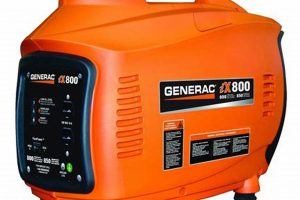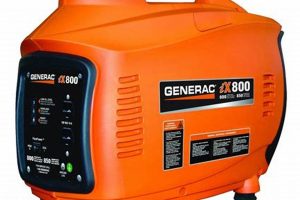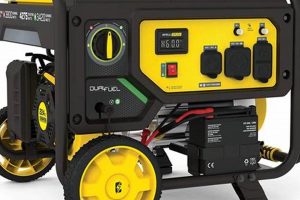Compact, fuel-driven electricity sources using propane offer a versatile power solution for various applications. Imagine a campsite illuminated, power tools operating far from an outlet, or essential appliances running during a power outage. This describes the functionality of these independent power units. They convert the chemical energy stored in propane into electrical energy, providing a reliable source of power where grid access is limited or unavailable.
These devices offer significant advantages in terms of portability, fuel efficiency, and environmental impact. Propane burns cleaner than gasoline, producing fewer emissions. Their self-contained design eliminates the need for extension cords and reduces the risk of tripping hazards. Historically, portable power generation relied heavily on gasoline. However, the demand for cleaner and more efficient alternatives propelled the development and adoption of propane-fueled models, leading to their widespread use in recreational activities, emergency preparedness, and professional applications.
This article delves into various aspects of these power sources, including their operation, maintenance, safety considerations, and selection criteria. Further exploration will cover the different types available, their power output capacities, and their suitability for specific purposes.
Operational Tips for Propane-Powered Generators
Safe and efficient operation of propane-fueled generators requires attention to several key practices. The following recommendations contribute to optimal performance and longevity while mitigating potential hazards.
Tip 1: Proper Ventilation is Crucial: Operate units exclusively in well-ventilated outdoor areas. Carbon monoxide poisoning is a serious risk in confined spaces.
Tip 2: Secure Fuel Connections: Before each use, inspect propane connections for leaks. Use soapy water to check for bubbles, indicating escaping gas.
Tip 3: Ground the Generator: Proper grounding is essential for electrical safety. Consult the owner’s manual for grounding instructions specific to the model.
Tip 4: Manage Electrical Loads: Avoid overloading the generator. Calculate the total wattage of devices to be powered and ensure it remains within the generator’s rated capacity.
Tip 5: Regular Maintenance: Adhere to the manufacturer’s recommended maintenance schedule. This typically includes oil changes, air filter cleaning, and spark plug replacement.
Tip 6: Safe Refueling Procedures: Turn off the generator and allow it to cool completely before refueling. Refuel in a well-ventilated area away from ignition sources.
Tip 7: Proper Storage: Store propane tanks upright in a cool, dry, and well-ventilated area, away from flammable materials.
Adhering to these guidelines ensures safe and reliable power generation, prolongs the lifespan of the equipment, and minimizes potential risks.
These operational tips contribute to the overall understanding of utilizing these valuable power resources safely and effectively. The concluding section summarizes the key information presented throughout this article.
1. Portability
Portability represents a defining characteristic of propane-powered generators, directly influencing their usability and suitability across diverse applications. This inherent mobility stems from compact design and relatively lightweight construction, enabling convenient transport to locations lacking traditional power sources. Consider a contractor powering tools on a remote job site, a family enjoying a weekend camping trip, or homeowners needing backup power during an outage. In each scenario, the generator’s portability facilitates essential operations and enhances convenience. This contrasts with larger, stationary generators requiring specialized transport and installation.
The practical significance of portability extends beyond mere convenience. Disaster relief efforts, for example, often rely on portable generators to power essential equipment in affected areas. Their transportability allows rapid deployment and flexible positioning, supporting critical operations in challenging environments. Furthermore, portability contributes to cost-effectiveness by eliminating the need for extensive wiring or complex infrastructure. This self-contained power solution minimizes setup time and maximizes operational flexibility.
While portability offers significant advantages, it also presents design and engineering challenges. Balancing power output with manageable weight and size requires careful optimization. Manufacturers employ advanced materials and efficient engine design to achieve this balance. Understanding the portability factor, therefore, necessitates considering the trade-offs between power capacity, operational duration, and physical dimensions. Selecting the right generator involves assessing these interconnected factors to match specific power needs with the desired level of portability.
2. Propane Fuel
Propane’s role as a fuel source is integral to the functionality of portable generators. Its chemical properties and storage characteristics make it a well-suited energy source for these devices. Combustion of propane with oxygen releases energy, converted into mechanical work by the generator’s engine, subsequently driving an alternator to produce electricity. This process relies on propane’s availability as a readily stored and transportable fuel. Unlike gasoline, propane remains stable in storage over extended periods, minimizing the risk of fuel degradation and ensuring reliable starting, even after prolonged periods of non-use. This characteristic is particularly crucial for emergency backup power applications. For example, homeowners preparing for power outages can store propane tanks for months or even years without compromising the generator’s ability to function when needed. Furthermore, propane’s clean-burning nature reduces emissions compared to gasoline-powered counterparts, contributing to a smaller environmental footprint. This factor gains importance in scenarios where minimizing air pollution is paramount, such as recreational activities or disaster relief operations.
The widespread availability of propane contributes to the practical utility of these generators. Propane can be readily purchased and stored in various tank sizes, offering flexibility in matching fuel supply to anticipated power demands. Exchanging empty tanks for pre-filled ones simplifies refueling, eliminating the need for on-site fuel handling. This ease of refueling contributes significantly to the convenience and reliability of propane-powered generators. Consider a construction crew working on a remote project. Access to readily available propane allows for continuous operation, minimizing downtime and maximizing productivity. In contrast, relying on gasoline might necessitate frequent trips to refuel, potentially disrupting workflow and increasing project costs. The utilization of propane streamlines operations and contributes to logistical efficiency in various professional applications.
Understanding the connection between propane fuel and portable generator functionality is essential for effective utilization and maintenance. Propane’s storage stability, clean-burning properties, and widespread availability collectively contribute to the reliability and versatility of these generators. While propane offers numerous advantages, considerations such as fuel cost fluctuations and the logistical requirements of propane supply should also be factored into operational planning. Matching fuel considerations with specific application needs ensures optimal generator performance and contributes to a comprehensive understanding of this essential power source.
3. Power Output
Power output, measured in watts, fundamentally determines the capabilities of a propane-powered portable generator. This metric signifies the amount of electrical energy the generator can produce, directly impacting the types and number of devices it can simultaneously power. A clear understanding of power output is crucial for matching the generator to specific needs. For instance, powering essential household appliances during a power outage requires a significantly higher power output than charging small electronic devices on a camping trip. Attempting to draw more power than the generator’s rated output leads to overloading, potentially damaging both the generator and connected devices. Therefore, accurate assessment of power requirements is paramount before selecting a generator.
The relationship between power output and fuel consumption is another critical consideration. Higher power output generally translates to increased propane usage. This correlation necessitates careful planning, especially for extended operations or emergency situations. A generator with ample power output but limited fuel efficiency may prove unsuitable for long-duration power needs. Conversely, a smaller, fuel-efficient generator might lack the capacity to power essential appliances during an outage. Balancing power output with fuel efficiency depends on the specific application and anticipated duration of use. Furthermore, the power output rating often encompasses two key figures: starting watts and running watts. Starting watts, higher than running watts, provide the initial surge of power required to start motor-driven appliances like refrigerators or air conditioners. Running watts represent the sustained power delivery for continuous operation. Discerning between these two ratings ensures that the generator can handle both the initial power surge and the ongoing operational load.
Effective utilization of propane-powered portable generators hinges on a comprehensive understanding of power output. Accurately assessing power needs, considering fuel efficiency, and differentiating between starting and running watts are essential for optimal generator selection and operation. Failure to consider these factors can result in inadequate power supply, generator damage, or excessive fuel consumption. Therefore, power output stands as a central element in the informed decision-making process regarding portable power solutions.
4. Runtime
Runtime, signifying the duration a portable propane-powered generator can operate on a single fuel tank, represents a critical performance characteristic. This duration directly influences the practical utility of these generators, especially in situations requiring extended power supply. Runtime is inextricably linked to fuel tank capacity and the generator’s fuel consumption rate. A larger fuel tank generally extends runtime, while a higher power output or heavier load tends to reduce it. Understanding this interplay is crucial for matching a generator’s capabilities to specific power needs. Consider a scenario requiring overnight power for essential medical equipment during a power outage. A generator with insufficient runtime necessitates refueling during the night, potentially disrupting critical operations. Conversely, for shorter-duration tasks like powering tools on a job site, a shorter runtime might suffice, prioritizing portability and cost-effectiveness over extended operation.
Practical applications often prioritize runtime optimization. Strategies for maximizing runtime include careful load management, utilizing the generator’s economy mode (if available), and ensuring proper maintenance. Operating the generator at less than its maximum capacity reduces fuel consumption, thereby extending runtime. Regular maintenance, including air filter cleaning and spark plug replacement, contributes to optimal engine efficiency and fuel economy. For instance, a homeowner using a generator for backup power during an outage might prioritize essential appliances over less critical loads to conserve fuel and extend the generator’s operational duration. Furthermore, understanding the impact of external factors like ambient temperature on runtime is crucial. Extreme temperatures can influence fuel consumption and engine performance, potentially affecting the expected runtime.
In summary, runtime stands as a pivotal factor in evaluating portable propane-powered generators. Its connection to fuel capacity, consumption rate, load management, and maintenance underscores the importance of considering operational requirements. Analyzing runtime alongside power output, portability, and other key characteristics allows for informed decisions, aligning generator capabilities with specific power demands. Understanding these interdependencies empowers users to maximize efficiency and ensure reliable power delivery in diverse applications.
5. Safety Features
Safety features represent critical components of propane-powered portable generators, mitigating inherent risks associated with fuel combustion and electricity generation. These integrated safeguards protect users, connected equipment, and the surrounding environment. A crucial safety mechanism is the low-oil shutdown feature. This sensor automatically shuts down the generator if the oil level drops below a safe threshold, preventing engine damage caused by insufficient lubrication. Such preventative measures reduce the risk of mechanical failure and potential fire hazards. Another vital safety feature is the automatic overvoltage protection. This circuitry safeguards connected devices from voltage spikes that could damage sensitive electronics. For example, during a power outage, a sudden surge in grid voltage upon restoration could harm appliances connected to the generator. Overvoltage protection prevents such damage, ensuring equipment safety. Furthermore, carbon monoxide (CO) detectors integrated into some models provide an additional layer of safety. CO, a colorless, odorless, and highly toxic gas, is a byproduct of propane combustion. These detectors monitor CO levels and trigger an alarm if concentrations exceed safe limits, alerting users to potential danger and enabling timely evacuation. This feature is particularly important in enclosed or poorly ventilated areas.
The practical significance of these safety features extends beyond individual use cases. In disaster relief scenarios, where portable generators often serve as critical power sources, integrated safety mechanisms protect both relief workers and affected communities. Reliable operation with minimized risks ensures continuity of essential services during emergencies. Furthermore, adherence to safety standards during manufacturing and rigorous testing procedures contribute to the overall reliability of these generators. For instance, certification by recognized safety organizations provides assurance that the generator meets established safety criteria. Understanding the interplay between safety features, design standards, and operational practices is crucial for mitigating potential hazards and ensuring safe power generation.
In conclusion, safety features constitute an integral aspect of portable propane-powered generator design and operation. These integrated safeguards protect users and equipment, playing a crucial role in diverse applications, from emergency power supply to recreational activities. Prioritizing generators with robust safety features, understanding their functionality, and adhering to safe operating practices are essential for maximizing the benefits of these power sources while minimizing inherent risks. Neglecting these aspects can lead to accidents, equipment damage, or even life-threatening situations. Therefore, a thorough understanding of safety considerations is paramount for responsible and effective utilization of portable propane-powered generators.
6. Maintenance
Maintenance plays a crucial role in ensuring the reliable and long-lasting performance of portable propane-powered generators. Neglecting routine maintenance can lead to decreased efficiency, mechanical failures, and potentially hazardous situations. A proactive maintenance approach maximizes the generator’s lifespan and ensures safe and dependable operation. The following facets highlight key maintenance aspects:
- Regular Oil Changes
Engine oil lubricates moving parts, reducing friction and heat. Over time, oil degrades, losing its lubricating properties. Regular oil changes, as specified in the owner’s manual, are essential for maintaining engine health and preventing premature wear. For example, failing to change the oil can lead to increased engine temperature, reduced efficiency, and ultimately, engine failure. Fresh oil ensures optimal engine performance and extends the generator’s lifespan.
- Air Filter Cleaning/Replacement
The air filter prevents dust and debris from entering the engine’s combustion chamber. A clogged air filter restricts airflow, reducing engine efficiency and increasing fuel consumption. Regular cleaning or replacement of the air filter, depending on operating conditions, is crucial for maintaining optimal performance. In dusty environments, more frequent air filter maintenance may be necessary. A clean air filter ensures proper combustion and maximizes fuel efficiency.
- Spark Plug Inspection/Replacement
Spark plugs ignite the air-fuel mixture in the engine’s combustion chamber. Over time, spark plugs can become fouled or worn, leading to misfires, reduced power output, and increased fuel consumption. Regular inspection and replacement of spark plugs, as recommended by the manufacturer, are essential for maintaining reliable engine operation. Worn spark plugs can cause difficulty starting the generator and decrease overall efficiency.
- Fuel System Inspection
Periodic inspection of the fuel system, including the propane tank, fuel lines, and connections, helps prevent leaks and ensures safe operation. Checking for leaks can be done using soapy water; the formation of bubbles indicates a leak. Addressing leaks promptly mitigates fire hazards and prevents fuel waste. Regular fuel system inspection contributes to safe and efficient generator operation.
These maintenance practices contribute significantly to the overall reliability and longevity of portable propane-powered generators. Adhering to the manufacturer’s recommended maintenance schedule ensures optimal performance, minimizes downtime, and extends the generator’s operational lifespan. Neglecting these essential tasks can lead to costly repairs, reduced efficiency, and potential safety hazards. A proactive maintenance approach represents a crucial investment in the long-term functionality and safety of these valuable power sources.
Frequently Asked Questions
This section addresses common inquiries regarding portable propane-powered generators, providing concise and informative responses.
Question 1: What are the primary advantages of propane-powered generators over gasoline-powered alternatives?
Propane offers several advantages. It burns cleaner, producing fewer emissions; it stores well without degradation, ensuring reliable starting after extended periods; and propane-fueled generators often operate more quietly.
Question 2: How is the runtime of a propane-powered generator determined?
Runtime depends on fuel tank capacity, the generator’s power output, and the connected load. Higher power demands reduce runtime. Manufacturer specifications typically provide runtime estimates under various load conditions.
Question 3: What safety precautions are essential when operating a propane-powered generator?
Operate generators outdoors in well-ventilated areas to prevent carbon monoxide poisoning. Ensure proper grounding and inspect fuel connections for leaks before each use. Never refuel a hot generator.
Question 4: How should a propane-powered generator be stored during the off-season?
Store generators in a dry, protected location. For extended storage, drain the fuel system or add a fuel stabilizer to prevent gumming. Disconnect the battery and consult the owner’s manual for model-specific storage recommendations.
Question 5: What maintenance tasks are essential for ensuring reliable generator performance?
Regular maintenance includes oil changes, air filter cleaning or replacement, spark plug inspection and replacement, and fuel system checks. Adhere to the manufacturer’s recommended maintenance schedule for optimal performance and longevity.
Question 6: How does one determine the appropriate generator size for specific needs?
Calculate the total wattage of devices to be powered simultaneously. Choose a generator with sufficient running watts to handle the continuous load and adequate starting watts to accommodate the initial surge of motor-driven appliances.
Addressing these common questions promotes informed decision-making and safe operation of propane-powered portable generators.
The subsequent section offers a concluding summary of key information presented throughout this article.
Conclusion
Portable propane-powered generators represent a versatile and reliable power solution for various applications. This exploration has examined key aspects, including operational guidelines, fuel considerations, power output, runtime, safety features, and maintenance requirements. The interplay of these factors underscores the importance of informed decision-making when selecting and utilizing these devices. Propane’s clean-burning properties, coupled with the portability and convenience of these generators, offer significant advantages over traditional gasoline-powered alternatives, particularly in situations requiring remote or emergency power supply. Furthermore, adherence to safety protocols and proactive maintenance ensures reliable performance and mitigates potential hazards. Understanding the nuances of power output, runtime calculations, and load management allows users to maximize efficiency and tailor generator capabilities to specific power demands.
The increasing demand for reliable and sustainable power sources underscores the continued relevance of portable propane-powered generators. Technological advancements promise further improvements in efficiency, noise reduction, and emission control. Careful consideration of the factors presented herein empowers individuals and organizations to harness the full potential of these generators while prioritizing safety and responsible usage. Informed selection and meticulous maintenance ensure that these portable power solutions remain a valuable asset across diverse applications, from recreational activities and emergency preparedness to professional operations and disaster relief efforts.






